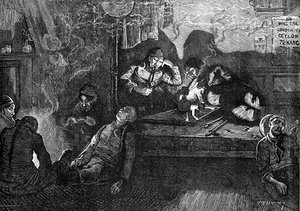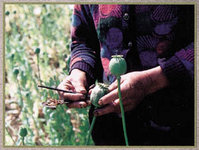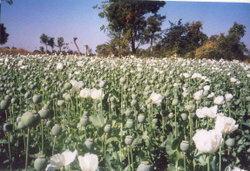Opium
Opium is a narcotic analgesic drug which is obtained from the unripe seed pods of the opium poppy (Papaver somniferum L. or the synonym paeoniflorum). more...
Harvesting opium
To harvest opium, the skin of the ripening pods is scored by a sharp blade. The slashes exude a white, milky latex, which dries to a sticky brown resin that is scraped off the pods as raw opium.
Opium has powerful narcotic properties. Its constituents and derivatives are used as painkillers in extreme circumstances, such as in terminal stages of cancer. Therefore, a small amount of legal production is discretely conducted under strict supervision by law enforcement. The leading legal producers of opium are France and Australia. The French company Francopia produces 20% to 25% of the world's total, with total sales of approximately 60 million € (1 Euro (EUR) = 1.2085 Dollar (USD)).
Opium preparation
Raw opium must be processed and refined (called "cooking") before it is suitable for smoking. The raw opium is first dissolved in water and simmered over a low heat. The brown solution is then filtered to remove the insoluble vegetable waxes and then evaporated over a low heat. The result is a smokable form of opium with a considerably higher morphine content percentage-wise than the raw latex. This is then pressed into bricks and either transported to heroin laboratories or used as is.
Although opium is used in the form of paregoric to treat diarrhea, most opium imported into the United States is broken down into its alkaloid constituents. These alkaloids are divided into two distinct chemical classes, phenanthrenes and isoquinolines. The principal phenanthrenes are morphine, codeine, and thebaine, while the isoquinolines have no significant central nervous system effects and are not regulated under the Controlled Substances Act. Opium is also processed into heroin, and most current drug use occurs with processed derivatives rather than with raw opium.
Seed Capsules
The seed capsules also contain morphine, codeine, and other alkaloids. These pods can be boiled in water to produce a bitter tea that induces a long-lasting intoxication. Addiction to poppy tea is rare, but does occur.
Chemical properties and physiological effects
Opium resin contains two groups of alkaloids: phenanthrenes (including morphine and codeine) and benzylisoquinolines (including papaverine). Morphine is by far the most prevalent and important alkaloid in opium, consisting of 10%-16% of the total. It binds to and activates μ-opioid receptors in the brain, spinal cord, stomach and intestine. Regular use, even for a few days, invariably leads to physical tolerance and dependence. Various degrees of psychological addiction can occur, though this is relatively rare when opioids are used for treatment of pain, rather than for euphoric effects. These mechanisms result from changes in nervous system receptors in response to the drug. In response to the drug, the brain creates new receptors for opiates. These receptors are "pseudo" receptors and do not work. When the opiates are out of the body, the brain has more receptors than before the use of the drug, but only the same amount of endogenous opiate (endorphins) to fill these receptors.
Read more at Wikipedia.org




